The April 25 earthquake devastated the otherwise picturesque region of Langtang; here’s a first-hand account of the horrific experience.
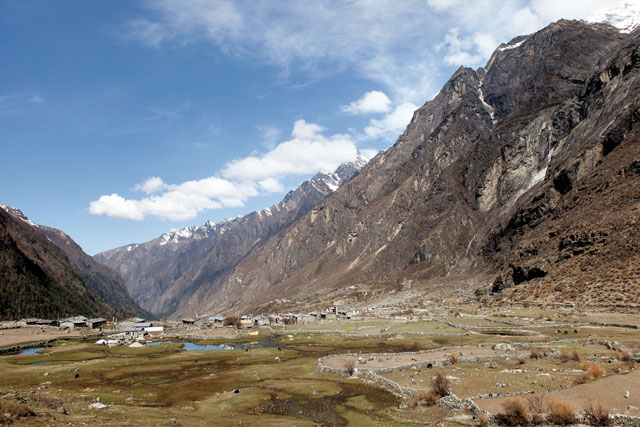
The air is cool, but sweet. Far from any motorized noises, it trills occasionally with the sound of birds, and gurgles constantly with the ever-present rhythm of the nearby river. The water is glacial, shallow, and bright, and my friend Ngaire and I are walking a pine-forested path that mimics its form. Around us, rhododendrons are bright with the flush of spring, thick moss clings to rock, and we catch glimpses of tiny squirrels. It is peaceful, but unlike the mythical Shangri-la, this is a real Himalayan utopia. This is Langtang.
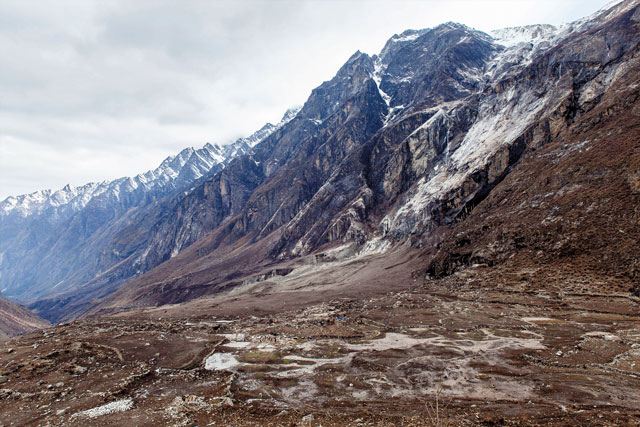 Approaching the village, which is the namesake of the valley, the land opens, giving way to yak pastures and the promise of pony rides for the weary. Ahead stretches an incredible mountain scene, each peak perfectly capped in snow. Langtang village—the largest in the valley, and hub for both the local Langtangpas and passing tourists—is no less idyllic on the eye. Our guesthouse that night is brand new, an impeccable two stone storeys, with a gorgeous young couple as proprietors; their two tiny children just old enough to make faces and play games with. Older children are playing in courtyards and lanes, making the most of their last days of school holiday. Old men chat in doorways, women braid one another’s hair on the stoops of old stone houses. The village is humble, and full of history.
Approaching the village, which is the namesake of the valley, the land opens, giving way to yak pastures and the promise of pony rides for the weary. Ahead stretches an incredible mountain scene, each peak perfectly capped in snow. Langtang village—the largest in the valley, and hub for both the local Langtangpas and passing tourists—is no less idyllic on the eye. Our guesthouse that night is brand new, an impeccable two stone storeys, with a gorgeous young couple as proprietors; their two tiny children just old enough to make faces and play games with. Older children are playing in courtyards and lanes, making the most of their last days of school holiday. Old men chat in doorways, women braid one another’s hair on the stoops of old stone houses. The village is humble, and full of history.

For four days we make our way through this landscape, into and then through Langtang village on our way to the valley’s end, to a smaller locale named Kyanjin Gompa. Cresting a ridge over the village, it was possible to look back and down over all the farmland, houses, and hotels, and see the tips of those beautiful forests we had left behind. Laden ponies pass us, and we pass local men bent under the weight of unwieldy loads. Leapfrogging at varying speeds up the trail, we make friends with other travelers moving at their own pace. A German family on their first trek, a photo-obsessed Malaysian, a Brit with three Taiwanese friends and 20 years experience.
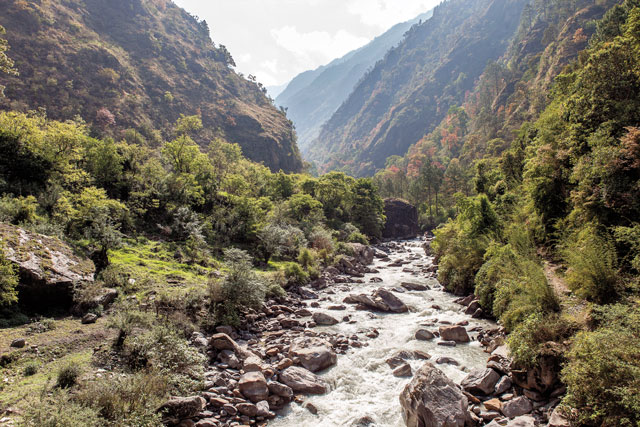 Sometimes together and sometimes apart, we all follow the long rows of mani stones toward an impossibly bright cradle of picturesque mountains. Across a bridge whipped by strong winds, with prayer flags horizontal in the breeze. Into a foggy, windy afternoon at Kyanjin on the afternoon of April 24.
Sometimes together and sometimes apart, we all follow the long rows of mani stones toward an impossibly bright cradle of picturesque mountains. Across a bridge whipped by strong winds, with prayer flags horizontal in the breeze. Into a foggy, windy afternoon at Kyanjin on the afternoon of April 24.
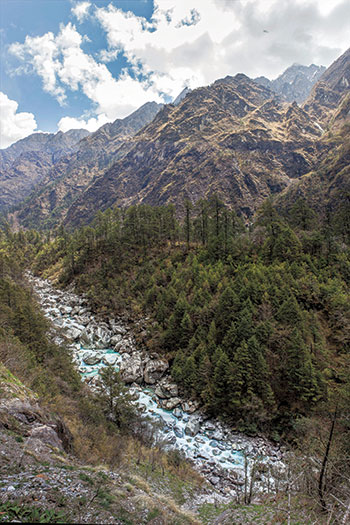 April 25, 2015. 11:55 a.m.
April 25, 2015. 11:55 a.m.
The day is thick, windless, and cold, and a fog hangs low over the village. It blankets out the mid slopes of the closely surrounding mountains, obscuring the peaks entirely. An Italian mountaineering group who had shared parmesan and salami with us the evening before have already departed our guesthouse, and we have risen late. Braving the cold air, we take a few hours in the morning to explore the misty, cobbled beginnings of the Langtang Khola nearby. We return to our room to read before lunch, our cheeks rosy from the chill.
I shift on the bed and stretch, turning a page in my beat-up, hostel copy of 2001: A Space Odyssey. The wind howls outside, incredibly loud. Impossibly loud, actually. It’s so strong that when I look up, it seems like our entire two-story stone hotel is moving. I look across at Ngaire, and ask, ‘Wind?’ But we are moving. One of us yells ‘Earthquake!’, and we both launch toward the door.
As we race down the hallway, veins pumping with adrenaline, the large rocks that made the eaves of the steep roof behind us crash into the room we have just left. Bouncing off the walls and down the stairs, we hurtle out the front door. The single-story kitchen building to our left is crumbling to pieces, as our hoteliers cling to each other by a low fence which is shaking itself apart. Heavy buildings all around are shedding pieces of themselves like feathers. The whole world is noise. The deepest sound, the pressure of tectonic plates shifting; it screams and howls as though we’re standing in a jet engine.
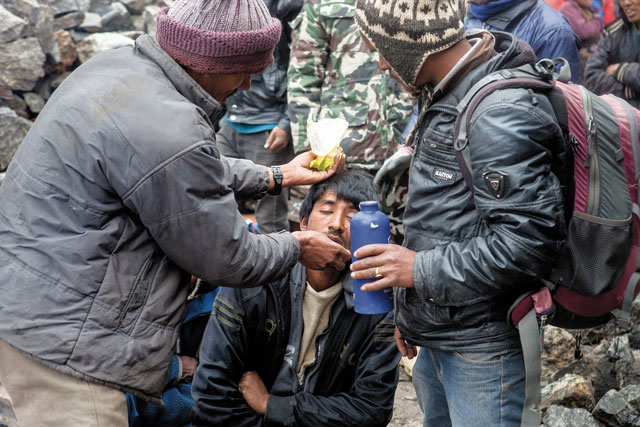
As suddenly as it began, it stops.
A young man near us is doubled over, blood streaming from a head wound. His friends are pressing a scarf to his scalp. People are gathered in the open, their eyes wide. I move to my friend, to touch, to connect, to ground ourselves again. But, there is a new sound.
It’s like a wave at the beach, an immense low crashing, and everyone turns just in time to see a billowing cloud cut through the low fog above Kyanjin. My body freezes, and my brain thinks ‘smoke’. For a millisecond I’m not worried, because it will be soft, we will be okay. But someone screams its true name. Avalanche! The cold crush of snow, ice, and mountain. Impossibly fast. We run.
I reach the corner of our hotel farthest from the mountains in vital seconds, but when I turn around, my friend is gone. I scream her name as the avalanche front rockets past me, and incredibly she is there, and I pull her in behind the building.
 Snow and ice plummet over and past us. The noise is like static in my head, it’s so immense. It is life in the balance. A rock twice the size of a fist falls from above us, striking the back of Ngaire’s head, and I pull her to the wall screaming, ‘Make a pocket for oxygen!’ One arm around and over her, both arms creating a pocket. My mind is blank, and I think honestly that we will die like this. That it will be slow and cold, and I know I will fight it, but how can we survive with our bodies trapped and lungs full of snow?
Snow and ice plummet over and past us. The noise is like static in my head, it’s so immense. It is life in the balance. A rock twice the size of a fist falls from above us, striking the back of Ngaire’s head, and I pull her to the wall screaming, ‘Make a pocket for oxygen!’ One arm around and over her, both arms creating a pocket. My mind is blank, and I think honestly that we will die like this. That it will be slow and cold, and I know I will fight it, but how can we survive with our bodies trapped and lungs full of snow?
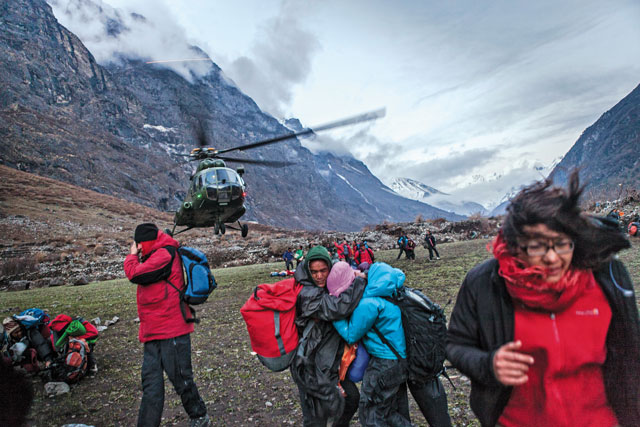 Moments stretch, seconds seem like minutes as snow and debris thunders past on either side and whips straight through the roof above us. I become aware of someone else behind the hotel with us, a woman calling out for her husband. Her shoulder-length hair is whipped horizontally and held in place with ice and snow. The wind stops, and everything is suddenly quiet. My voice is shaking, and with no shoes or gloves, our fingers and feet feel like foreign objects. But we are alive.
Moments stretch, seconds seem like minutes as snow and debris thunders past on either side and whips straight through the roof above us. I become aware of someone else behind the hotel with us, a woman calling out for her husband. Her shoulder-length hair is whipped horizontally and held in place with ice and snow. The wind stops, and everything is suddenly quiet. My voice is shaking, and with no shoes or gloves, our fingers and feet feel like foreign objects. But we are alive.
Kyanjin Gompa still stands, but barely. The majority of buildings had been built of stone, and are shattered like Lego. Almost every roof is gone.
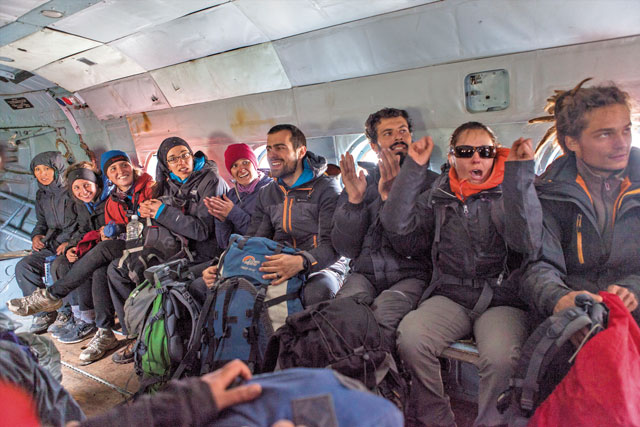 Langtang is gone
Langtang is gone
In the aftermath of the dual disasters, large groups of shell-shocked locals, guides, and tourists make the decision to trek south to Langtang. At a larger village, we all feel there will be more options there, and that we will have a better chance of calling for help. Local people are making the descent to check on family and friends, and in turn, I feel deeply concerned for the people that we met on our ascent. After the trauma collectively experienced in Kyanjin, it was impossible to entertain that the destruction could be greater anywhere else.
The path down the valley is indistinguishably treacherous and changed, covered in rocks and snow. The mani stones have slipped and tumbled. People begin to pass us, heading up to Kyanjin, and their words distress the Nepalis. ‘Langtang is gone’, they translate. We think they mean ‘gone’ like Kyanjin; bruised, but certainly not broken. Certainly not wiped from the map. Of course, we have no way of knowing how wrong we are.
On the flats above the hilly ridge over Langtang village stands a low building, near completion. Built to serve as a new hospital for the valley, the shockwave from the fall over Langtang has shredded the roof and ceiling from the otherwise solid structure. It will be our sanctuary until rescue. Upon arrival, my heart soars; there is our British mate Mick and his Taiwanese friends. They were first on the scene, and by the time we arrived hours later, there are several fires and some rough shelter. The building is swamped with survivors. The horror on the faces of the Langtangpas scars me to the core. ‘Have you been to the ridge?’ Mick asks. ‘You’re not going to believe it.’
It would take days of staring back at the place where Langtang had stood for me to realize the intensity of what had happened there. And, even then, even now, it is beyond belief. The beautiful new hotel with the sweet young family we had stayed with, there is no trace of it. How could an entire village of over 300 people just vanish?
Langtang New Hospital
That night, over 100 people settle as best they can within the confines of the New Hospital walls, with only a little rough shelter, a few small fires, and no food or water. And on that first night, it rains.
What was to come was many days of waiting in uncertainty. Five days to be exact, but it was the not knowing that crippled. We wake with hope each morning, only to put it back to bed a little after midday, as the clouds roll in for the afternoon and any rescue helicopter trips cease. A heroic, solitary pilot named Dougie Gray makes it his mission to take as many rescue trips up the valley as the weather allows, taking many wounded back with him. Our crowd downsizes from over 120 to 70, but new wounded still appear daily. A military contingent is dropped in one morning on reconnaissance, but they are under-prepared and without supplies. The dirty snow melts, two bags of rice show up, and our water source all but vanishes from the rock-face it had once poured down. We sleep in four hour shifts in order to tend the fires at night, feeding them with broken window frames. Aftershocks send us scrambling every time, the fall of rocks echoing down the valley. Five long days, softened only by the company of people with incredible strength, generosity, and humor.
Being human
No two experiences or personal reactions in the aftermath of disaster can possibly be the same. Within such a large group of survivors, we had over 15 nationalities at any time, from small children to seasoned locals and travelers. Some tourists had lost new friends, and our guides and porters were stranded in a deep silence, unable to know how their families fared at home. And the Langtangpas had lost people, homes, livelihoods, and so much of their historical and cultural grounding. Thrust into close proximity in this improvised community, so many feelings overflowed to be experienced in one way or another by everyone. Tears, laughter, fights, conversation, gossip, and charity were all a part of the combined experience of surviving and suffering. Every act was a story of being human, of living on.
It was guides reappearing after an up-valley absence with a super-sized kettle, some tea bags and a jar of salvaged cardamom pods. We drank the weak tea out of empty mackerel tins.
It was in talking about movies, books, television, and trivia in order to stay upright at night, staving off chronic exhaustion to keeping a fire going for ourselves and our roommates.
It was lists made and sent out with the wounded, paper cries for help, relief, assistance. Attempts to let our families know we still lived.
It was one of Mick’s porters showing up with a non-descript black garbage bag containing a few packets of noodles, broken biscuits, muesli bars, and a jar of peanut butter. Extra calories to stave off the cold.
It was hearing incredible stories of survival from our fellow travelers. Of the humility and courage of their guides, the expertise which saved them, and which brought them down mountains and to safety.
It was humor as a response to a desperate situation, using art as an outlet to create rudimentary charcoal drawings on the walls to make light of a dark time.
In the midst of all this, an Israeli man, working for a private disaster response firm, was dropped with us on day four. He said that the next day, weather permitting, we would all be rescued.
The fifth day
April 29 dawns just like every other, early and cold, but this time, the hope we rise with is tangible. Over the hours, cloud from lower in the valley rises with the temperature, slowly like a thick and uncomfortable blanket. The longer we spend under its cover, the longer all of us in the upper valley spend in anxious wait, praying that our hope is not in vain.
Wisps of mist chase past New Hospital until we can see all the way down the valley. And then we hear it. The sound of rotor blades cutting through cold air. A military helicopter! Over the next hour or so, it makes several passes up and down the valley to and from Kyanjin. Just before 10 in the morning, they are ready for us. Grabbing our things, we all form one line for women and one for men, and prepare to leave. It is surreal.
Ngaire and I are on the second flight out from New Hospital, crammed in like grateful sardines with the rest of the women and the first of the men. The helicopter, it’s like sitting in an enormous washing machine, shaking and roaring. After initial cheers as the doors close behind us, the faces around me are pale, people are crying. The men left on the ground are waving up at us as we take off. We see the New Hospital from above, and the salvation of those solid walls seems so small, before we are swept up above the destruction. Beyond Langtang village, forests are flattened, the river itself has changed course, and there are many landslides. The horrified silence in the helicopter is swallowed by the strong and steady chug of the MI8 taking us away from a place which is destined to stay with us forever.









